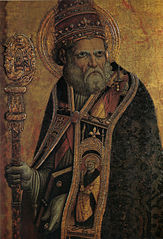
Domenico Veneziano was an Italian painter of the early Renaissance, active mostly in Perugia and Tuscany.

Lorenzo Monaco was an Italian painter and miniaturist of the late Gothic to early Renaissance age. He was born Piero di Giovanni. Little is known about his youth, apart from the fact that he was apprenticed in Florence. He has been considered the last important exponent of the Giotto style, before the Renaissance revolution that came with Fra Angelico and Masaccio.

Pietro Lorenzetti or Pietro Laurati was an Italian painter, active between c. 1306 and 1345. Together with his younger brother Ambrogio, he introduced naturalism into Sienese art. In their artistry and experiments with three-dimensional and spatial arrangements, the brothers foreshadowed the art of the Renaissance.

Pietro Perugino, an Italian Renaissance painter of the Umbrian school, developed some of the qualities that found classic expression in the High Renaissance. Raphael became his most famous pupil.

Carlo Crivelli was an Italian Renaissance painter of conservative Late Gothic decorative sensibility, who spent his early years in the Veneto, where he absorbed influences from the Vivarini, Squarcione, and Mantegna. He left the Veneto by 1458 and spent most of the remainder of his career in the March of Ancona, where he developed a distinctive personal style that contrasts with that of his Venetian contemporary Giovanni Bellini.

The Polyptych of the Misericordia is a painting conserved in the Museo Civico di Sansepolcro in the town of Sansepolcro, region of Tuscany, Italy. The painting is one of the earliest works of the Italian Renaissance painter Piero della Francesca, who was born in the town. The central panel is of the common motif of the Virgin of Mercy or Madonna della Misericordia.

Bernardo Daddi was an early Italian Renaissance painter and the leading painter of Florence of his generation. He was one of the artists who contributed to the revolutionary art of the Renaissance, which broke away from the conventions of the preceding generation of Gothic artists, by creating compositions which aimed to achieve a more realistic representation of reality. He was particularly successful with his small-scale works and contributed to the development of the portable altarpiece, a format that subsequently gained great popularity.
The decade of the 1450s in art involved many significant events, especially in sculpture.
The decade of the 1430s in art involved some significant events.

The San Zeno Altarpiece is a polyptych altarpiece by the Italian Renaissance painter Andrea Mantegna created around 1456–1459. It remains in situ in the Basilica di San Zeno, the main church of the Northern Italian city of Verona. Mantegna's style mixes Greco-Roman classical themes along with Christian subjects in this altarpiece. The central panel, along with the three paintings that comprise the predella, were taken in 1797 by the French. While the main, central scene was returned by the French to Verona in 1815, the three predella paintings in Verona today are copies, since the original ones remain in France at the Louvre (Crucifixion) and in the Musée des Beaux-Arts in Tours. The paintings are made with tempera on panel; not oil as mistakenly identified in one source.
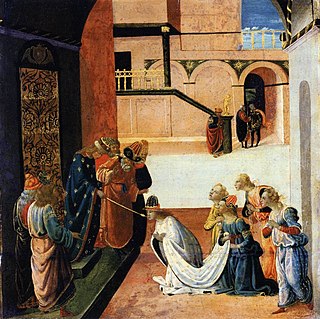
Jacopo del Sellaio (1441/42–1493), was an Italian painter of the early Renaissance, active in his native Florence. His real name was Jacopo di Arcangelo. He worked in an eclectic style based on those of Botticelli, Filippino Lippi, and Domenico Ghirlandaio. The nickname Sellaio derives from the profession of his father, a saddle maker.
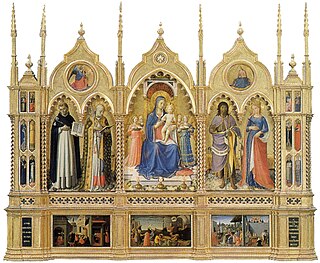
The Perugia Altarpiece is a painting by the Italian early Renaissance painter Fra Angelico, housed in the Galleria Nazionale dell'Umbria of Perugia, Italy.
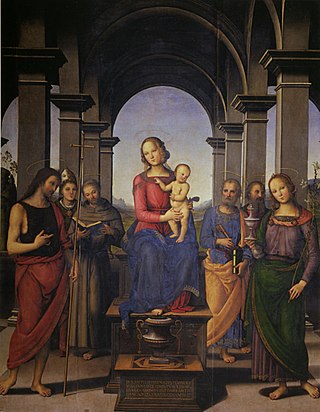
The Fano Altarpiece is a painting by the Italian Renaissance artist Pietro Perugino, executed in 1497, and housed in the church of Santa Maria Nuova, Fano, central Italy. It also includes a lunette with a Pietà and several predella panels.
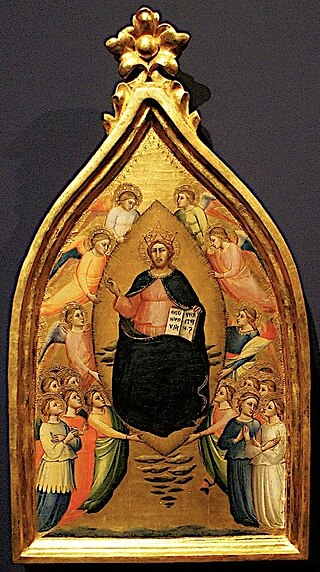
Mariotto di Nardo di Cione was a Florentine painter in the Florentine Gothic style. He worked at the Duomo of Florence, the church of Santa Maria Maggiore, and the Orsanmichele. He created both frescoes and panel paintings, and was also active as a manuscript illuminator.

The Pesaro Altarpiece is an oil-on-panel painting by the Italian artist Giovanni Bellini, dated to some time between 1471 and 1483. It is considered one of Bellini's first mature works, though there are doubts on its dating and on who commissioned it. The work's technique is not only an early use of oils but also of blue smalt, a by-product of the glass industry. It had already been used in the Low Countries in Bouts' 1455 The Entombment, but this marked smalt's first use in Italian art, twenty years before Leonardo da Vinci used it in Ludovico il Moro's apartments in Milan in 1492. Bellini also uses the more traditional lapis lazuli and azurite for other blues in the work.
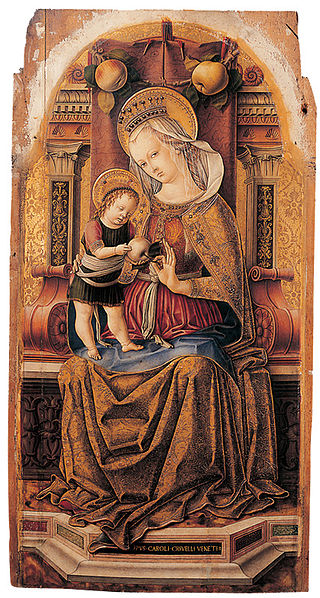
The St Peter Martyr Altarpiece or Minor San Domenico Altarpiece is a altarpiece in tempera and gold on panel by the Italian Renaissance painter Carlo Crivelli, executed c. 1476. Its central panel of the Madonna and Child, signed "OPVS CAROLI CRIVELLI VENETI", is now in the Museum of Fine Arts in Budapest. The altarpiece's other panels were seen in Rome by Luigi Lanzi in 1789 before being moved to Florence with the Rinuccini family. In 1868 it moved from the Demidov collection to the National Gallery in London, where they still hang.

The 1476 Altarpiece or San Domenico Altarpiece is a 1476 tempera and gold on panel altarpiece by the Italian Renaissance painter Carlo Crivelli. Its central panel of the Pietà is now in the Metropolitan Museum of Art in New York, whilst the other nine are now in the National Gallery, London.
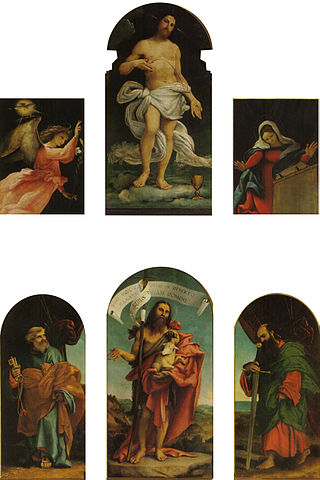
The Ponteranica Altarpiece is a six-panel oil painting series produced by Lorenzo Lotto in 1522, commissioned by the Scuola del Corpo di Cristo for the parish church of San Vincenzo e Sant'Alessandro in Ponteranica, where it still remains. Its upper register shows the risen Christ flanked by an Annunciation scene, whilst below is John the Baptist flanked by saints Peter and Paul.
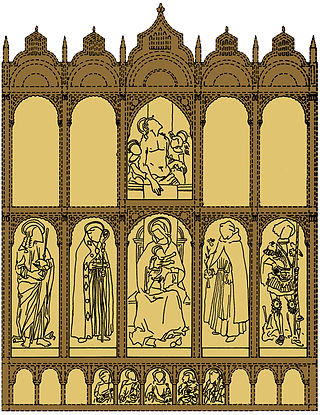
The 1472 Altarpiece was a tempera and oil on panel altarpiece by the Italian Renaissance painter Carlo Crivelli, dated 1472 on the central panel. Also known as the Fesch Altarpiece or the Eckinson Altarpiece, it is now divided up between a number of galleries in the United States and Europe.

The Porto San Giorgio Altarpiece or Porto San Giorgio Polytpych was a 1470 multi-panel tempera and gold on panel altarpiece by the Italian Renaissance painter Carlo Crivelli. Stylistically similar to Crivelli's Massa Fermana Altarpiece, the work was a fundamental step in his evolution away from the Paduan Renaissance towards a more delicate and realist style.





